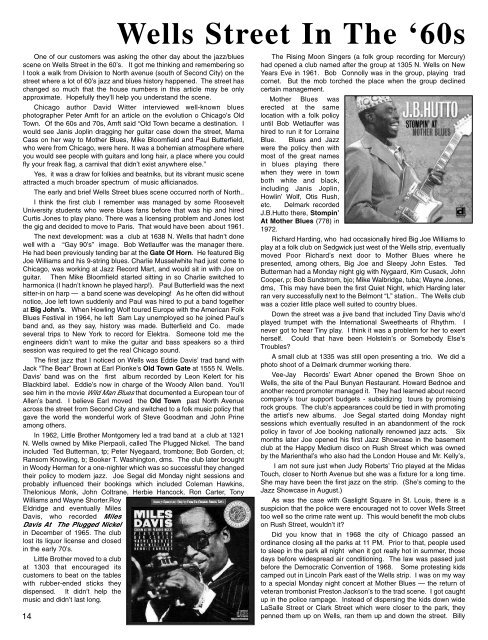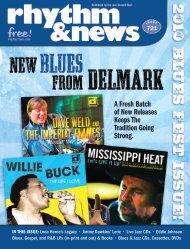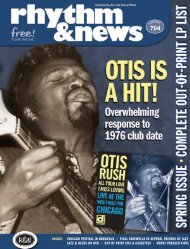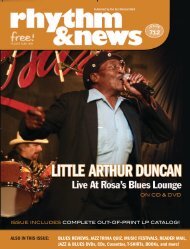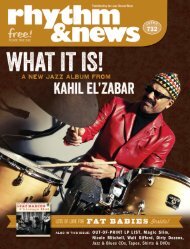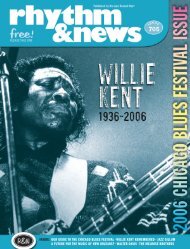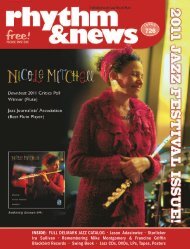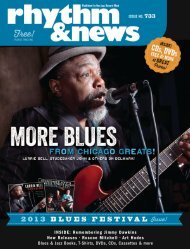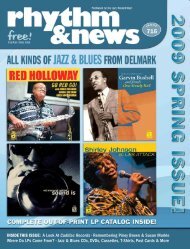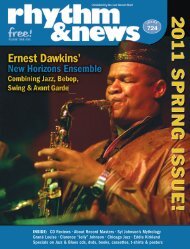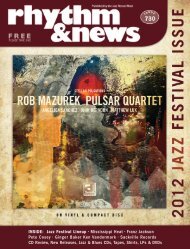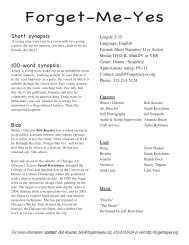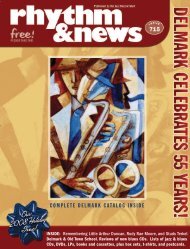INSIDE: DETAILED DELMARK BLUES ... - Delmark Records
INSIDE: DETAILED DELMARK BLUES ... - Delmark Records
INSIDE: DETAILED DELMARK BLUES ... - Delmark Records
You also want an ePaper? Increase the reach of your titles
YUMPU automatically turns print PDFs into web optimized ePapers that Google loves.
One of our customers was asking the other day about the jazz/blues<br />
scene on Wells Street in the 60’s. It got me thinking and remembering so<br />
I took a walk from Division to North avenue (south of Second City) on the<br />
street where a lot of 60’s jazz and blues history happened. The street has<br />
changed so much that the house numbers in this article may be only<br />
approximate. Hopefully they’ll help you understand the scene.<br />
Chicago author David Witter interviewed well-known blues<br />
photographer Peter Amft for an article on the evolution o Chicago’s Old<br />
Town. Of the 60s and 70s, Amft said “Old Town became a destination. I<br />
would see Janis Joplin dragging her guitar case down the street, Mama<br />
Cass on her way to Mother Blues, Mike Bloomfield and Paul Butterfield,<br />
who were from Chicago, were here. It was a bohemian atmosphere where<br />
you would see people with guitars and long hair, a place where you could<br />
fly your freak flag, a carnival that didn’t exist anywhere else.”<br />
Yes, it was a draw for folkies and beatniks, but its vibrant music scene<br />
attracted a much broader spectrum of music afficianados.<br />
The early and brief Wells Street blues scene occurred north of North..<br />
I think the first club I remember was managed by some Roosevelt<br />
University students who were blues fans before that was hip and hired<br />
Curtis Jones to play piano. There was a licensing problem and Jones lost<br />
the gig and decided to move to Paris. That would have been about 1961.<br />
The next development: was a club at 1638 N. Wells that hadn’t done<br />
well with a “Gay 90’s” image. Bob Wetlauffer was the manager there.<br />
He had been previously tending bar at the Gate Of Horn. He featured Big<br />
Joe Williams and his 9-string blues. Charlie Musselwhite had just come to<br />
Chicago, was working at Jazz Record Mart, and would sit in with Joe on<br />
guitar. Then Mike Bloomfield started sitting in so Charlie switched to<br />
harmonica (I hadn’t known he played harp!). Paul Butterfield was the next<br />
sitter-in on harp — a band scene was developing! As he often did without<br />
notice, Joe left town suddenly and Paul was hired to put a band together<br />
at Big John’s. When Howling Wolf toured Europe with the American Folk<br />
Blues Festival in 1964, he left Sam Lay unemployed so he joined Paul’s<br />
band and, as they say, history was made. Butterfield and Co. made<br />
several trips to New York to record for Elektra. Someone told me the<br />
engineers didn’t want to mike the guitar and bass speakers so a third<br />
session was required to get the real Chicago sound.<br />
The first jazz that I noticed on Wells was Eddie Davis’ trad band with<br />
Jack “The Bear” Brown at Earl Pionke’s Old Town Gate at 1555 N. Wells.<br />
Davis’ band was on the first album recorded by Leon Kelert for his<br />
Blackbird label. Eddie’s now in charge of the Woody Allen band. You’ll<br />
see him in the movie Wild Man Blues that documented a European tour of<br />
Allen’s band. I believe Earl moved the Old Town past North Avenue<br />
across the street from Second City and switched to a folk music policy that<br />
gave the world the wonderful work of Steve Goodman and John Prine<br />
among others.<br />
In 1962, Little Brother Montgomery led a trad band at a club at 1321<br />
N. Wells owned by Mike Pierpaoli, called The Plugged Nickel. The band<br />
included Ted Butterman, tp; Peter Nyegaard, trombone; Bob Gorden, cl;<br />
Ransom Knowling, b; Booker T. Washington, dms. The club later brought<br />
in Woody Herman for a one-nighter which was so successful they changed<br />
their policy to modern jazz. Joe Segal did Monday night sessions and<br />
probably influenced their bookings which included Coleman Hawkins,<br />
Thelonious Monk, John Coltrane, Herbie Hancock, Ron Carter, Tony<br />
Williams and Wayne Shorter.Roy<br />
Eldridge and eventually Miles<br />
Davis, who recorded Miles<br />
Davis At The Plugged Nickel<br />
in December of 1965. The club<br />
lost its liquor license and closed<br />
in the early 70’s.<br />
Little Brother moved to a club<br />
at 1303 that encouraged its<br />
customers to beat on the tables<br />
with rubber-ended sticks they<br />
dispensed. It didn’t help the<br />
music and didn’t last long.<br />
14<br />
Wells Street In The ‘60s<br />
The Rising Moon Singers (a folk group recording for Mercury)<br />
had opened a club named after the group at 1305 N. Wells on New<br />
Years Eve in 1961. Bob Connolly was in the group, playing trad<br />
cornet. But the mob torched the place when the group declined<br />
certain management.<br />
Mother Blues was<br />
erected at the same<br />
location with a folk policy<br />
until Bob Wetlauffer was<br />
hired to run it for Lorraine<br />
Blue. Blues and Jazz<br />
were the policy then with<br />
most of the great names<br />
in blues playing there<br />
when they were in town<br />
both white and black,<br />
including Janis Joplin,<br />
Howlin’ Wolf, Otis Rush,<br />
etc. <strong>Delmark</strong> recorded<br />
J.B.Hutto there, Stompin’<br />
At Mother Blues (778) in<br />
1972.<br />
Richard Harding, who had occasionally hired Big Joe Williams to<br />
play at a folk club on Sedgwick just west of the Wells strip, eventually<br />
moved Poor Richard’s next door to Mother Blues where he<br />
presented, among others, Big Joe and Sleepy John Estes. Ted<br />
Butterman had a Monday night gig with Nygaard, Kim Cusack, John<br />
Cooper, p; Bob Sundstrom, bjo; Mike Walbridge, tuba; Wayne Jones,<br />
dms, This may have been the first Quiet Night, which Harding later<br />
ran very successfully next to the Belmont “L” station.. The Wells club<br />
was a cozier little place well suited to country blues.<br />
Down the street was a jive band that included Tiny Davis who’d<br />
played trumpet with the International Sweethearts of Rhythm. I<br />
never got to hear Tiny play. I think it was a problem for her to exert<br />
herself. Could that have been Holstein’s or Somebody Else’s<br />
Troubles?<br />
A small club at 1335 was still open presenting a trio. We did a<br />
photo shoot of a <strong>Delmark</strong> drummer working there.<br />
Vee-Jay <strong>Records</strong>’ Ewart Abner opened the Brown Shoe on<br />
Wells, the site of the Paul Bunyan Restaurant. Howard Bednoe and<br />
another record promoter managed it. They had learned about record<br />
company’s tour support budgets - subsidizing tours by promising<br />
rock groups. The club’s appearances could be tied in with promoting<br />
the artist’s new albums. Joe Segal started doing Monday night<br />
sessions which eventually resulted in an abandonment of the rock<br />
policy in favor of Joe booking nationally renowned jazz acts. Six<br />
months later Joe opened his first Jazz Showcase in the basement<br />
club at the Happy Medium disco on Rush Street which was owned<br />
by the Marienthal’s who also had the London House and Mr. Kelly’s,<br />
I am not sure just when Judy Roberts’ Trio played at the Midas<br />
Touch, closer to North Avenue but she was a fixture for a long time.<br />
She may have been the first jazz on the strip. (She’s coming to the<br />
Jazz Showcase in August.)<br />
As was the case with Gaslight Square in St. Louis, there is a<br />
suspicion that the police were encouraged not to cover Wells Street<br />
too well so the crime rate went up. This would benefit the mob clubs<br />
on Rush Street, wouldn’t it?<br />
Did you know that in 1968 the city of Chicago passed an<br />
ordinance closing all the parks at 11 PM. Prior to that, people used<br />
to sleep in the park all night when it got really hot in summer, those<br />
days before widespread air conditioning. The law was passed just<br />
before the Democratic Convention of 1968. Some protesting kids<br />
camped out in Lincoln Park east of the Wells strip. I was on my way<br />
to a special Monday night concert at Mother Blues — the return of<br />
veteran trombonist Preston Jackson’s to the trad scene. I got caught<br />
up in the police rampage. Instead of dispersing the kids down wide<br />
LaSalle Street or Clark Street which were closer to the park, they<br />
penned them up on Wells, ran them up and down the street. Billy


